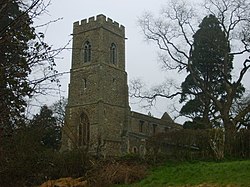Little Gransden
| Little Gransden | |
| Cambridgeshire | |
|---|---|
 St Peter & St Paul Church, Little Gransden | |
| Location | |
| Grid reference: | TL272552 |
| Location: | 52°10’48"N, 0°8’24"W |
| Data | |
| Population: | 262 (2001) |
| Post town: | Sandy |
| Postcode: | SG19 |
| Dialling code: | 01767 |
| Local Government | |
| Council: | South Cambridgeshire |
Little Gransden is a little village and parish in Cambridgeshire, in the south of the county, 11 miles from Cambridge and close up to the Huntingdonshire border. Its larger neighbour, Great Gransden is in Huntingdonshire.
In 2001 the parish population was 262.
Little Gransden has two airfields, one of which was used in Second World War.
History
The village's name is Old English, from 'Granta's valley' after an otherwise unknown landowner of ancient times. It was spelled Grantandene in 973 and Grante(s)dene in the 1086 Domesday Book.[1]
Woodland was important in the settlement's early history; there was enough to support 60 pigs in 1086. By 1251, a large area of woodland in the south-east of the parish had been split into Hayley Wood and Littlehound Wood (the latter no longer exists, but the shape can still be seen in field boundaries).
Little Gransden village evolved as an offshoot of Great Gransden. The church and manor house of the abbey of Ely face Great Gransden across the low-lying land along Home Dole Brook; the village grew southwards from a street alongside the brook. There were 56 inhabited houses in 1666, but the number had dropped to 38 by 1801. By 1961 there were 84 houses.
Due to its isolated location, there were no inns in the village until 1800, though by the 1840s there were four (the Sun in Church Lane, the Chequers, the Double Chequers at Mill Hill and the Hardwicke Arms). In 1834, the overseer of the poor considered that an excess of beer-houses may have been partly responsible for recent problems. Only the Chequers was left after 1967.
Despite the heaviness of the soil, most of the parish land has been used mainly for arable farming. It was cultivated in three open fields until parliamentary inclosure in 1814. High, flat land in the east of the parish was hard to drain before mechanisation and was usually used for pasture and as the village common. In 1940, after the outbreak of Second World War, the area was made into an airfield, called Gransden Lodge Airfield. It was in operational use from 1941 to 1946 but was unoccupied after 1948 and then sold off. Since October 1991 it has been the home of the Cambridge Gliding Centre.
Parish church
The parish church, dedicated to Saints Peter and Paul, was built from stone in the 13th century and comprises a chancel, nave of four bays aisles and an embattled western tower containing three bells. In 1858 the chancel was restored and its east end rebuilt; a stained window was put in by the Rev. Alfred Newby, a former rector, in 1875. The church was restored in 1885-8 at a cost of £700.
Sights about the village
The parish has two airfields: Little Gransden Airfield, located at Fuller's Hill Farm, which holds an air and car show every summer;[2] and Gransden Lodge, a former Royal Air Force station which saw active service in Second World War, but is now a gliding site,[3] its three paved runways having been removed.
A cross in the churchyard commemorates Little Gransden men who were killed in the two world wars.[4]
There are 16 listed buildings in the village, including the Old Rectory, the parish church and various houses.
Outside links
| ("Wikimedia Commons" has material about Little Gransden) |
References
- ↑ Mills, A.D. (1998). A Dictionary of English Place-names. Second Edition. Oxford University Press, Oxford. p159. ISBN 0-19-280074-4
- ↑ Little Gransden Charity Air & Car Show
- ↑ Cambridge Gliding Centre: About us
- ↑ Roll of Honour.com: Little Gransden